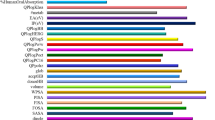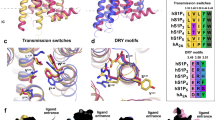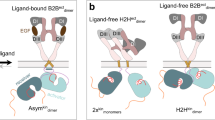Abstract
Members of the tumor necrosis factor receptor superfamily (TNFRSF) are important therapeutic targets that can be activated to induce death of cancer cells or stimulate proliferation of immune cells. Although it has long been implicated that these receptors assemble preligand associated states that are required for dominant interference in human disease, such states have so far eluded structural characterization. Here, we find that the ectodomain of death receptor 5 (DR5-ECD), a representative member of TNFRSF, can specifically self-associate when anchored to lipid bilayer, and we report this self-association structure determined by nuclear magnetic resonance (NMR). Unexpectedly, two non-overlapping interaction interfaces are identified that could propagate to higher-order clusters. Structure-guided mutagenesis indicates that the observed preligand association structure is represented on DR5-expressing cells. The DR5 preligand association serves an autoinhibitory role as single-___domain antibodies (sdAbs) that partially dissociate the preligand cluster can sensitize the receptor to its ligand TRAIL and even induce substantial receptor signaling in the absence of TRAIL. Unlike most agonistic antibodies that require multivalent binding to aggregate receptors for activation, these agonistic sdAbs are monovalent and act specifically on an oligomeric, autoinhibitory configuration of the receptor. Our data indicate that receptors such as DR5 can form structurally defined preclusters incompatible with signaling and that true agonists should disrupt the preligand cluster while converting it to signaling-productive cluster. This mechanism enhances our understanding of a long-standing question in TNFRSF signaling and suggests a new opportunity for developing agonistic molecules by targeting receptor preligand clustering.
Similar content being viewed by others
Login or create a free account to read this content
Gain free access to this article, as well as selected content from this journal and more on nature.com
or
Data availability
All data are available in the main text or the supplementary materials. The atomic structure coordinate and structural constraints have been deposited in the Protein Data Bank (PDB) with accession number 8DPX. The chemical shift values have been deposited in the Biological Magnetic Resonance Data Bank (BMRB) with accession number 31034.
References
Chen, Z., Oh, D., Biswas, K. H., Zaidel-Bar, R. & Groves, J. T. Probing the effect of clustering on EphA2 receptor signaling efficiency by subcellular control of ligand-receptor mobility. Elife 10, e67379 (2021).
Janes, P. W., Nievergall, E. & Lackmann, M. Concepts and consequences of Eph receptor clustering. Semin. Cell Dev. Biol. 23, 43–50 (2012).
Zhang, X., Gureasko, J., Shen, K., Cole, P. A. & Kuriyan, J. An allosteric mechanism for activation of the kinase ___domain of epidermal growth factor receptor. Cell 125, 1137–1149 (2006).
Wu, H. Higher-order assemblies in a new paradigm of signal transduction. Cell 153, 287–292 (2013).
Dustin, M. L. & Groves, J. T. Receptor signaling clusters in the immune synapse. Annu. Rev. Biophys. 41, 543–556 (2012).
Graves, J. D. et al. Apo2L/TRAIL and the death receptor 5 agonist antibody AMG 655 cooperate to promote receptor clustering and antitumor activity. Cancer Cell 26, 177–189 (2014).
Hymowitz, S. G. et al. Triggering cell death: the crystal structure of Apo2L/TRAIL in a complex with death receptor 5. Mol. Cell 4, 563–571 (1999).
Adams, C. et al. Structural and functional analysis of the interaction between the agonistic monoclonal antibody Apomab and the proapoptotic receptor DR5. Cell Death Diff. 15, 751–761 (2008).
Shivange, G. et al. A patch of positively charged residues regulates the efficacy of clinical DR5 antibodies in solid tumors. Cell Rep. 37, 109953 (2021).
Schlessinger, J. Ligand-induced, receptor-mediated dimerization and activation of EGF receptor. Cell 110, 669–672 (2002).
Burgess, A. W. et al. An open-and-shut case? Recent insights into the activation of EGF/ErbB receptors. Mol. Cell 12, 541–552 (2003).
Reshetnyak, A. V. et al. Mechanism for the activation of the anaplastic lymphoma kinase receptor. Nature 600, 153–157 (2021).
Eck, M. J. & Sprang, S. R. The structure of tumor necrosis factor-alpha at 2.6 A resolution. Implications for receptor binding. J. Biol. Chem. 264, 17595–17605 (1989).
Compaan, D. M. & Hymowitz, S. G. The crystal structure of the costimulatory OX40-OX40L complex. Structure 14, 1321–1330 (2006).
Banner, D. W. et al. Crystal structure of the soluble human 55 kd TNF receptor-human TNF beta complex: implications for TNF receptor activation. Cell 73, 431–445 (1993).
Mongkolsapaya, J. et al. Structure of the TRAIL-DR5 complex reveals mechanisms conferring specificity in apoptotic initiation. Nat. Struct. Biol. 6, 1048–1053 (1999).
Himanen, J. P. et al. Architecture of Eph receptor clusters. Proc. Natl. Acad. Sci. USA 107, 10860–10865 (2010).
Wang, F. et al. Structures of mouse and human GITR-GITRL complexes reveal unique TNF superfamily interactions. Nat. Commun. 12, 1378 (2021).
Chan, F. K. et al. A ___domain in TNF receptors that mediates ligand-independent receptor assembly and signaling. Science 288, 2351–2354 (2000).
Naismith, J. H., Devine, T. Q., Brandhuber, B. J. & Sprang, S. R. Crystallographic evidence for dimerization of unliganded tumor necrosis factor receptor. J. Biol. Chem. 270, 13303–13307 (1995).
Siegel, R. M. et al. Fas preassociation required for apoptosis signaling and dominant inhibition by pathogenic mutations. Science 288, 2354–2357 (2000).
Kumar, R. et al. Increased sensitivity of antigen-experienced T cells through the enrichment of oligomeric T cell receptor complexes. Immunity 35, 375–387 (2011).
Kramer, J. M. et al. Evidence for ligand-independent multimerization of the IL-17 receptor. J. Immunol. 176, 711–715 (2006).
Ashkenazi, A. Targeting the extrinsic apoptosis pathway in cancer. Cytokine Growth Factor Rev. 19, 325–331 (2008).
Watts, T. H. TNF/TNFR family members in costimulation of T cell responses. Ann. Rev. Immunol. 23, 23–68 (2005).
Wajant, H. Principles of antibody-mediated TNF receptor activation. Cell Death Differ. 22, 1727–1741 (2015).
Aggarwal, B. B. Signalling pathways of the TNF superfamily: a double-edged sword. Nat. Rev. Immunol. 3, 745–756 (2003).
Locksley, R. M., Killeen, N. & Lenardo, M. J. The TNF and TNF receptor superfamilies: integrating mammalian biology. Cell 104, 487–501 (2001).
Bodmer, J. L., Schneider, P. & Tschopp, J. The molecular architecture of the TNF superfamily. Trends Biochem. Sci. 27, 19–26 (2002).
Vanamee, E. S. & Faustman, D. L. Structural principles of tumor necrosis factor superfamily signaling. Sci. Signal. 11, eaao4910 (2018).
Karathanasis, C. et al. Single-molecule imaging reveals the oligomeric state of functional TNFalpha-induced plasma membrane TNFR1 clusters in cells. Sci. Signal. 13, eaax5647 (2020).
Fu, Q. et al. Structural basis and functional role of intramembrane trimerization of the Fas/CD95 death receptor. Mol. Cell 61, 602–613 (2016).
Valley, C. C. et al. Tumor necrosis factor-related apoptosis-inducing ligand (TRAIL) induces death receptor 5 networks that are highly organized. J. Biol. Chem. 287, 21265–21278 (2012).
Bitra, A. et al. Crystal structure of murine 4-1BB and its interaction with 4-1BBL support a role for galectin-9 in 4-1BB signaling. J. Biol. Chem. 293, 1317–1329 (2018).
Zhao, L., Fu, Q., Pan, L., Piai, A. & Chou, J. J. The diversity and similarity of transmembrane trimerization of TNF receptors. Front. Cell Dev. Biol. 8, 569684 (2020).
Goh, E. T. H. et al. A small molecule targeting the transmembrane ___domain of death receptor p75(NTR) induces melanoma cell death and reduces tumor growth. Cell Chem. Biol. 25, 1485–1494.e5 (2018).
Pan, L. et al. Higher-order clustering of the transmembrane anchor of DR5 drives signaling. Cell 176, 1477–1489.e14 (2019).
Pickford, A. R. & O’Leary, J. M. Isotopic labeling of recombinant proteins from the methylotrophic yeast Pichia pastoris. Methods Mol. Biol. 278, 17–33 (2004).
Li, B. et al. Activation of the proapoptotic death receptor DR5 by oligomeric peptide and antibody agonists. J. Mol. Biol. 361, 522–536 (2006).
Fu, Q., Piai, A., Chen, W., Xia, K. & Chou, J. J. Structure determination protocol for transmembrane ___domain oligomers. Nat. Protoc. 14, 2483–2520 (2019).
Battiste, J. L. & Wagner, G. Utilization of site-directed spin labeling and high-resolution heteronuclear nuclear magnetic resonance for global fold determination of large proteins with limited nuclear overhauser effect data. Biochemistry 39, 5355–5365 (2000).
Clore, G. M. & Iwahara, J. Theory, practice, and applications of paramagnetic relaxation enhancement for the characterization of transient low-population states of biological macromolecules and their complexes. Chem. Rev. 109, 4108–4139 (2009).
Piai, A., Fu, Q., Dev, J. & Chou, J. J. Optimal bicelle size q for solution nmr studies of the protein transmembrane partition. Chemistry 23, 1361–1367 (2017).
Piai, A. et al. Structural basis of transmembrane coupling of the HIV-1 envelope glycoprotein. Nat. Commun. 11, 2317 (2020).
Cromie, K. et al. Agonist DR5 binding polypeptides. WO2011/098520 A1 (2011).
Romei, M. G. & Boxer, S. G. Split green fluorescent proteins: scope, limitations, and outlook. Annu. Rev. Biophys. 48, 19–44 (2019).
Huet, H. A. et al. Multivalent nanobodies targeting death receptor 5 elicit superior tumor cell killing through efficient caspase induction. MAbs 6, 1560–1570 (2014).
Wagner, K. W. et al. Death-receptor O-glycosylation controls tumor-cell sensitivity to the proapoptotic ligand Apo2L/TRAIL. Nat. Med. 13, 1070–1077 (2007).
Lo, C. H. et al. Noncompetitive inhibitors of TNFR1 probe conformational activation states. Sci. Signal. 12, aav5637 (2019).
Wang, L. et al. The Fas-FADD death ___domain complex structure reveals the basis of DISC assembly and disease mutations. Nat. Struct. Mol. Biol. 17, 1324–1329 (2010).
Scott, F. L. et al. The Fas-FADD death ___domain complex structure unravels signalling by receptor clustering. Nature 457, 1019–1022 (2009).
Croft, M., Benedict, C. A. & Ware, C. F. Clinical targeting of the TNF and TNFR superfamilies. Nat. Rev. Drug Discov. 12, 147–168 (2013).
Rogers, P. R., Song, J., Gramaglia, I., Killeen, N. & Croft, M. OX40 promotes Bcl-xL and Bcl-2 expression and is essential for long-term survival of CD4 T cells. Immunity 15, 445–455 (2001).
Sheridan, J. P. et al. Control of TRAIL-induced apoptosis by a family of signaling and decoy receptors. Science 277, 818–821 (1997).
Morgan, W. D., Kragt, A. & Feeney, J. Expression of deuterium-isotope-labelled protein in the yeast pichia pastoris for NMR studies. J. Biomol. NMR 17, 337–347 (2000).
Vold, R. R. & Prosser, R. S. Magnetically oriented phospholipid bilayered micelles for structural studies of polypeptides. Does the ideal bicelle exist? J. Magn. Res. Ser. B 113, 267–271 (1996).
Sanders, C. R. 2nd & Schwonek, J. P. Characterization of magnetically orientable bilayers in mixtures of dihexanoylphosphatidylcholine and dimyristoylphosphatidylcholine by solid-state NMR. Biochemistry 31, 8898–8905 (1992).
Kucerka, N. et al. Structure of fully hydrated fluid phase DMPC and DLPC lipid bilayers using X-ray scattering from oriented multilamellar arrays and from unilamellar vesicles. Biophys. J. 88, 2626–2637 (2005).
Delaglio, F. et al. NMRPipe: a multidimensional spectral processing system based on UNIX pipes. J. Biomol. NMR 6, 277–293 (1995).
Bartels, C., Xia, T. H., Billeter, M., Guntert, P. & Wuthrich, K. The program XEASY for computer-supported NMR spectral analysis of biological macromolecules. J. Biomol. NMR 6, 1–10 (1995).
Vranken, W. F. et al. The CCPN data model for NMR spectroscopy: development of a software pipeline. Proteins 59, 687–696 (2005).
Salzmann, M., Wider, G., Pervushin, K. & Wuthrich, K. Improved sensitivity and coherence selection for [15N,1H]-TROSY elements in triple resonance experiments. J. Biomol. NMR 15, 181–184 (1999).
Kay, L. E., Ikura, M., Tschudin, R. & Bax, A. Three-dimensional triple-resonance NMR spectroscopy of isotopically enriched proteins. J. Magn. Reson. 213, 423–441 (1990).
Schwieters, C. D., Kuszewski, J., Tjandra, N. & Clore, G. M. The Xplor-NIH NMR molecular structure determination package. J. Magn. Reson. 160, 66–74 (2002).
Shen, Y., Delaglio, F., Cornilescu, G. & Bax, A. TALOS+: a hybrid method for predicting protein backbone torsion angles from NMR chemical shifts. J. Biomol. NMR 44, 213–223 (2009).
Chou, J. J., Li, S., Klee, C. B. & Bax, A. Solution structure of Ca(2+)-calmodulin reveals flexible hand-like properties of its domains. Nat. Struct. Biol. 8, 990–997 (2001).
Piai, A., Dev, J., Fu, Q. & Chou, J. J. Stability and water accessibility of the trimeric membrane anchors of the HIV-1 envelope spikes. J. Am. Chem. Soc. 139, 18432–18435 (2017).
Ashkenazi, A. et al. Safety and antitumor activity of recombinant soluble Apo2 ligand. J. Clin. Invest. 104, 155–162 (1999).
Kischkel, F. C. et al. Cytotoxicity-dependent APO-1 (Fas/CD95)-associated proteins form a death-inducing signaling complex (DISC) with the receptor. EMBO J. 14, 5579–5588 (1995).
Acknowledgements
This work was supported by NIH grants GM140887 (to J.J.C.) and AI150709 (to J.J.C. and H.W.). The NMR data were collected at the MIT-Harvard CMR (supported by NIH grants P41 GM132079 and S10 OD023513).
Author information
Authors and Affiliations
Contributions
G.D., L.Z., H.W., and J.J.C. conceived the study; G.D. and L.Z. prepared samples and performed NMR analyses; G.D. and J.J.C. determined the structures; Y.Z. and G.D. performed sdAb analyses; A.B. and T.C. performed initial feasibility study of DR5 ECD; G.D. performed the FRET and cell assays; G.D., L.Z., and B.X. performed split-GFP experiments; K.H., K.V.D.H., M.-A.B., M.B., and L.-L.L. developed and prepared NANOBODY® compounds; J.J.C. and G.D. wrote the manuscript and all others helped with editing the manuscript.
Corresponding authors
Ethics declarations
Competing interests
The authors declare no competing interests.
Rights and permissions
Springer Nature or its licensor (e.g. a society or other partner) holds exclusive rights to this article under a publishing agreement with the author(s) or other rightsholder(s); author self-archiving of the accepted manuscript version of this article is solely governed by the terms of such publishing agreement and applicable law.
About this article
Cite this article
Du, G., Zhao, L., Zheng, Y. et al. Autoinhibitory structure of preligand association state implicates a new strategy to attain effective DR5 receptor activation. Cell Res 33, 131–146 (2023). https://doi.org/10.1038/s41422-022-00755-2
Received:
Accepted:
Published:
Issue Date:
DOI: https://doi.org/10.1038/s41422-022-00755-2
This article is cited by
-
Induction of IL6/STAT3-dependent TRAIL expression that contributes to the therapeutic efficacy of osimertinib in EGFR mutant NSCLC cells
Oncogene (2025)
-
CD95/Fas stoichiometry in future precision medicine
Cell Death & Differentiation (2025)
-
Characterizing the regulatory Fas (CD95) epitope critical for agonist antibody targeting and CAR-T bystander function in ovarian cancer
Cell Death & Differentiation (2023)
-
Death receptor 5 rises to the occasion
Cell Research (2023)



